|
|
|
About This Site |
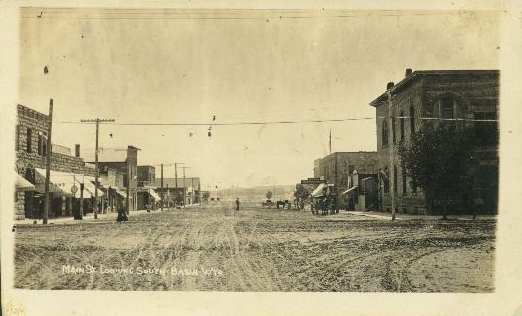 Basin, Wyoming, approx. 1910 Basin City was formed in 1896 by Winfield S. Collins with the thought that upon the formation of Big Horn County it would become the new county seat. Intitially, it was believed that Otto on the Greybull River had the edge. The outcome, however, was determined when Cody entered the race and drew off enough votes to assure Basin City's victory by a margin of 44 votes--even though the "City" only had 33 voters.
The Big Horn River forms Sheep Canyon through Sheep Mountain north of Greybull. At the turn of the century, several companies of Mormons from Utah and the area around Evanston established a colony in the Big Horn Basin. At the time the Burlington and Northern Railroad was considering extension of its line south from Pryor Gap Montana south into Wyoming. I.S.P Weeks an engineer for the Railroad contracted with a company of Mormons to extend the line twenty miles to Frannie. Ultimately, the Mormons provided the labor for 100 miles of the line and well as providing the labor for other public works projects including the Shoshoni Dam. The Basin City Herald promoted the arid, sagebrush-strewn townsite as being in the "banana belt" of Wyoming and extolled: "the Gem of the Plains, a charming location with glorious scenery with beautiful surroundings, queen city of the state nearest the center of population, easiest approach, accessible at all times, the center of a rich farming section. The townsite being on the eastern slope, is bathed in sunshine. It may be truly said of Basin City that the spendor of dawn and the glories of sunshine caress the spot." The promotion of the city as being in a banana belt ended in January, 1899, when the temperature dropped to 50 below. Until the coming of the railroad, growth was slow. Dstances were great. On November 18, 1900, the Baptists dedicated their new church. The church cost about $1,000. Among those attending was the Baptist General Missionary for Montana, Southern Idaho, Utah and Wyoming, the Reverend L. G. Clark. The distance to Basin City from where the railroad ended was some 105 miles. The Reverend Clark noted in The Home Mission Monthly, January 1901, that the stage "would often go fron twenty to thirty miles without passing a human being, going on and on through the sage brush and the sand, over the mountains and across the valleys." The return trip proved to be perilous: A continuous ride in an open stage of about 110 miles, facing wind and snow, with weather from four to fourteen degrees below zero. A midnight, Monday the 19th, we came to the banks of one of the rivers we were obliged to ford. The shore ice was so bad that our hourses did not want to cross, but after looking matters over a little the driver decided to attempt to cross. At last the horses plunged into the river, but soon refused to go on; one of them fell down, and after getting on his feet again made a desperate attempt to get out on the same side of the river we started from. The stage came near being turned over. After we got out, we were obliged to drive back three miles, where, after much trouble, we succeeded to fording the river, first breaking the ice, then riding one of the horses across first, and at last succeeding in getting the team to cross with the stage.  Basin, Wyoming, approx. 1909 Nevertheless, the "city" continued to grow and was incorporated as a municipality in 1902 with Collins as mayor. This, however, provided a dilemma. In the promotional lanquage of Wyoming the use of the term "city" in the name of a place, usually meant that it wasn't, i.e. Bear River City, Hamilton City, South Pass City, Atlantic City and Platinum City. The solution was the same as that utilized by Green River City, the term "City" was dropped and the town became simply "Basin."
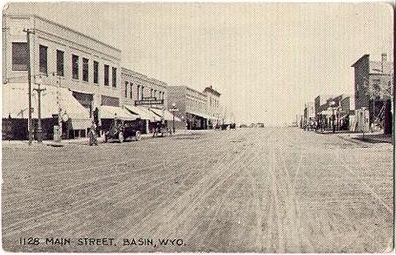 Basin, Wyoming, approx. 1910
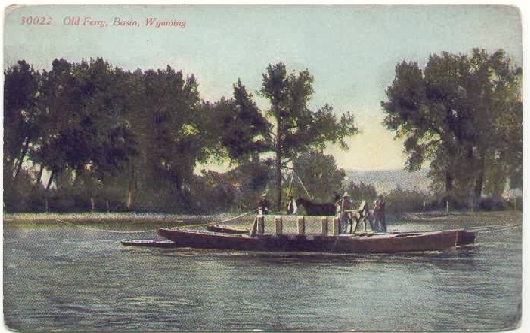 Ferry Across Big Horn River, Basin, Wyoming, undated With the exception of a few toll bridges and the Military Bridge at Ft. Laramie, until the early years of the 20th Century, the principal means of crossing streams was either by fording the stream or through the use of cable ferries, such as depicted above. Through the use of cables or ropes and pulleys which varied the angle of the craft with relation to the stream, the current could be made to push the ferry across the river in either direction, much in the same manner as one may tack against the wind in a sail boat. On the Big Horn, A. G. Rupp operated a ferry at the turn of the century at Welling or Wellington, three miles south of Manderson. Welling was named after Rupp's son, Wellington Rupp. In addition to operating the ferry, Rupp was postmaster and operated a store and corral. Among his customers was Butch Cassidy who visited the store following the Wilcox robbery and paid Rupp $20.00. Rupp later was a partner in the Worland Grit, a newspaper published at Camp Worland, before the town moved across the river.
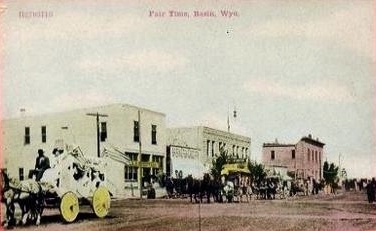 Parade for County Fair, Basin, Wyoming, 1912
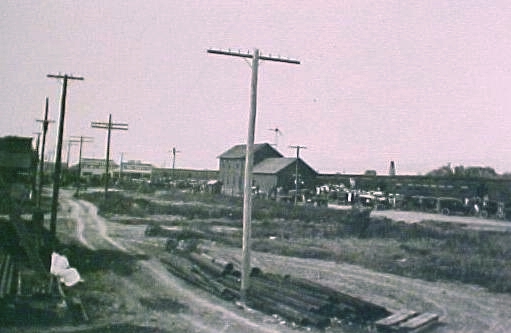 Troops boarding trains for World War I, Basin, Wyo., 1917 Wyoming was less isolationist than the Midwest and with the advent of the War, Wyoming contributed 12,000 men to military service, above the national average. Ten per cent of the population of Washakie County, as an example, joined one of the services. The Wyoming National Guard became part of the 41st Division in France in December, 1917. Basin, in addition to active duty troops, formed a home-guard unit. Patriotism was the rule of the day. One individual who criticized President Wilson was required to demonstrate his patriotism by publicly kissing the flag.
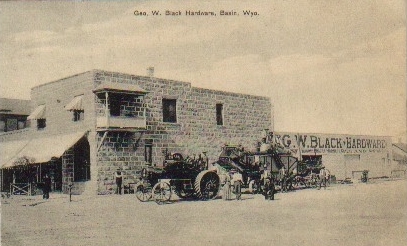 George W. Black Hardware Store, Basin, Wyoming, approx. 1910
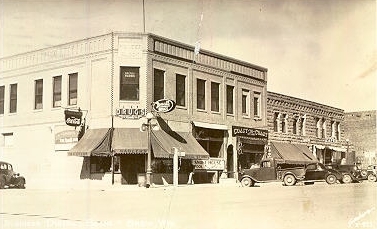 Basin, Wyoming, 1937 Music this page:
Days are very long; I'm a-growing weary only List'ning for your song. Old remembrances are thronging Thro' my memory. Till it seems the world is full of dreams Just to call you back to me. Chorus:
There's a long, long trail a-winding
All night long I hear you calling, Chorus:
There's a long, long trail a-winding Big Horn Basin continued on next page, Thermopolis and Meeteetse. |
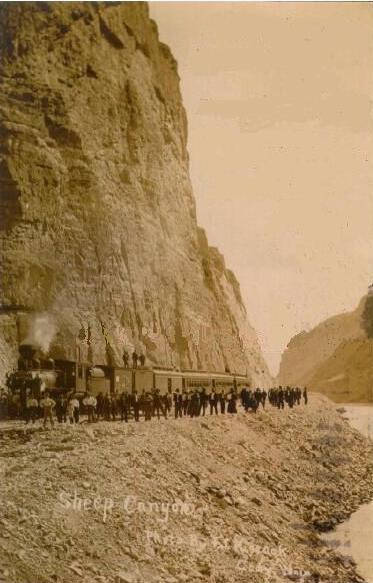 Sheep Canyon, 1907, photo by F. J. Hiscock
Sheep Canyon, 1907, photo by F. J. Hiscock
